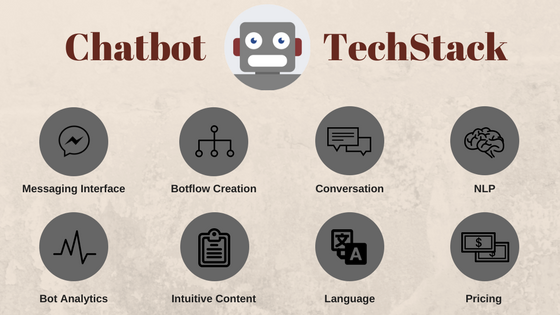A Complete Guide on Chatbot Architecture
Intelligent messaging solutions can actually help deliver stupendous results and better experiences at a very attractive cost per contact. To achieve...
Big data has become a go-to technology to help make most of the management decisions today. Up until 2009, before the launch of Hadoop, Big Data was a far-off dream for many. With cloud computing and growing range of intelligent tools and solutions, it is now not just possible but also very confusing. With so many languages, tools, services, and solutions available, it becomes challenging to choose the right technology stack for big data projects. Since the success of a project depends on the technology stack you choose, it is a very important decision. In this blog, we will give you some key factors to consider while choosing the right big data technology stack.

Integration of your digital application with data sources is an unavoidable aspect to manage your data perfectly. But we might think that it is a common phenomenon that almost every system allows. It is not a miracle anyway. But when it comes to digital data, there are certain factors that you need to consider:
The name “Big Data” itself implies what it actually is. Big Data can be used in each and every core business processes. The key factor behind Big data is to enable better decision making. This will be a possibility only when the data is handled properly without any hazards. Data has to be stored and maintained in such a way that it can be available for any future reference. There have been drastic improvements in scanning large files, parallelism, handling cardinality issues and workload handling and analyzing. While dealing with outbound integration, the stream-based joints and complexities involved in it must not be forgotten.
Big Data allows you to analyze the data, optimize your business on occurrence with a Marketing perspective. Obtaining insights about your customers and able to apply it in your customer conversation is inevitable for flourishing business relationships. According to Waterford technologies, 39% of marketers have complained that they have 0 to very little details regarding consumer behavior. This could very well be replaced with realistic data to analyze customer behavior. This way, you can host successful E-Mail campaigns, enjoy better CRM systems.
Feeding the data in and fetching realistic data is a huge challenge. Make sure you have a proper Big Data tool to perform this tedious task.
39 percent of marketers have complained about the inaccuracy of data which is not pertaining to real time. This is also a huge challenge since data has to be collected, integrated, analyzed and decisions have to be taken on it. Customer relationship is expected to grow tremendously compared to previous statistics.
According to IBM, it is essential to take following actions
Big data does not support data flow and analytic to full passes or parallelwise properly. The most common technology stack approach to real-time has been to evaluate the database as much as needed and to move as much as possible of the database along with its work-in memory. This will pave way for fast joint movements of data and use complex event processing data to facilitate one-on-one customer data streams.
Depending on your needs and availability, pick out the technology stack that best fits your application. If you belong to digital marketing, you might need to spend more bucks on the real-time decision, market automation, and CRM. So, plan according to how you use.
Since there are terabytes of data involved, the cloud server might be temporarily down or may not load on time. This is a common issue in businesses with multiple stores and for multinational companies, where they have users from all over the world. To avoid this conflict, you can add an ETL layer. You need not concern about load without disruption anymore, with ETL.
Business Intelligence has evolved into a large area for dealing with complex web-based reporting, It is a better tool for data analyzing and can be relied upon effectively. The Digital data which you have acquired can be integrated with BI tools for a better result. Data surfacing challenges can be very well handled with this tool. It is not a tough challenge anymore with BI tools.
Use tools like SAS and SPSS for in-house statistical analysis and better modeling capabilities. These tools are known for providing better data transformation facilities. Since there is a huge volume of data, this process might not be simple. The parallelism of data might not be easily possible. There are many complexities involved which demands team expertise and high requirements on the technology stack.
Procedural language access is a must since the data streams are large and the volume of data is soaring high. Big Data supports procedural or algorithmic queries. It is a bit complicated but to enable better data management, it is a must. It will rekindle efficient management of data to a whole new level.
Companies mostly buy Big Data Analytics tools only based on the single-use factor. They are less concerned about multiple purposes it can serve. A software should be able to optimize itself according to user needs. It should not be vice versa. A software tool must be robust, versatile and agile. It must be reconfigurable and must easily optimize with customer demands. This will surely benefit the company in its long run.
The software tool must be able to point down in case of any errors. A software tool which can offer proper heads up is what we prefer, rather than manually handling and finding out if there is any error. This will enable companies to make better decisions and avoid many blunders.
Report by Waterford technologies suggests that there are hardly 140,000 to 190,000 experts with deep knowledge of data analytics. This is not going to suffice the demand for Big Data by 2018. Companies must make sure that they appoint highly skilled experts to handle with highly complex languages like SQL. This will ensure that data management is done more professionally than ever. Also, experts must not deny the complexities that Big Data involves. They must be able to sort it down properly on time. The tool you choose should be popular enough so that you can get required developers.
Choosing the right Big Data technology stack is a must for companies to manage their data properly. This way, companies will benefit from great customer relationship management (CRM) and better decision-making skills. This will lead to profitable turnovers for your venture.
Have a Big Data project? Contact today.

Intelligent messaging solutions can actually help deliver stupendous results and better experiences at a very attractive cost per contact. To achieve...
A group of large data sets that cannot be processed using traditional computing techniques is known a Big Data. In the processing of Big Data...

There was a time when pacing an outdoor banner seemed to be the most you do in marketing. Fast-forward to today marketers are analyzing every action...
